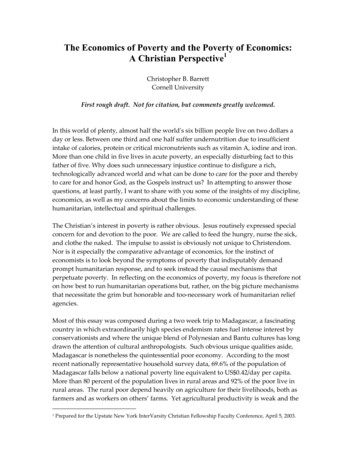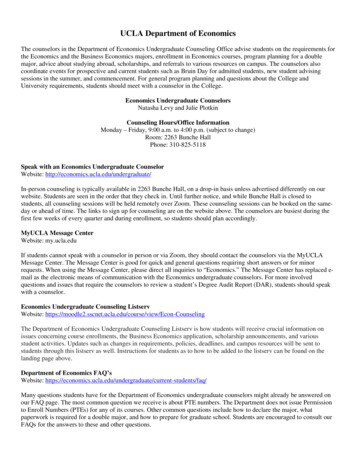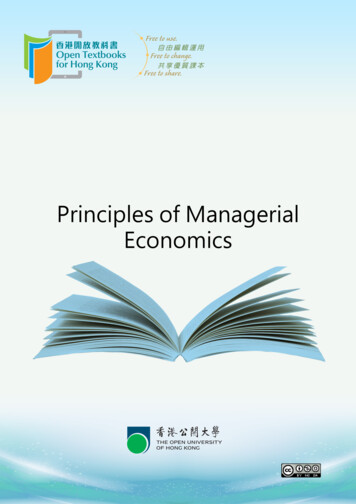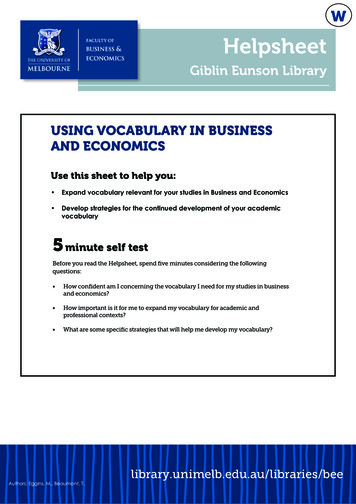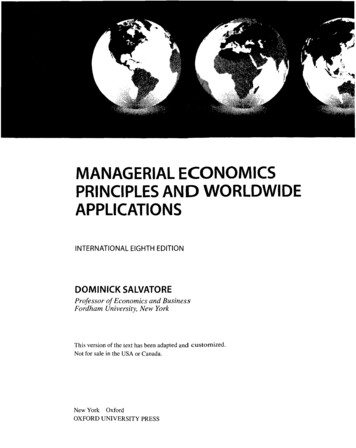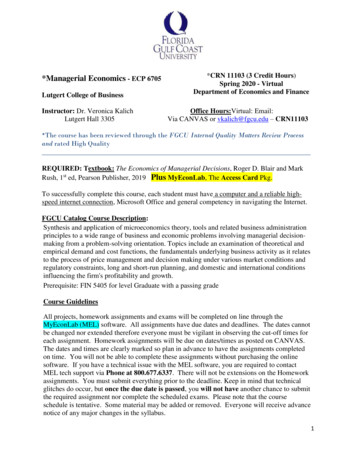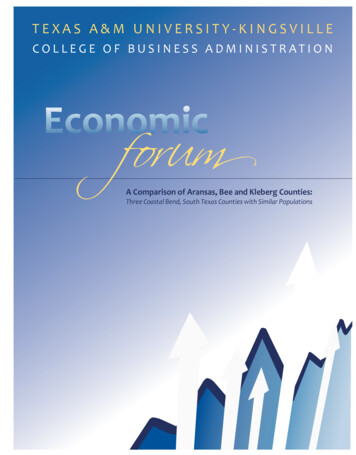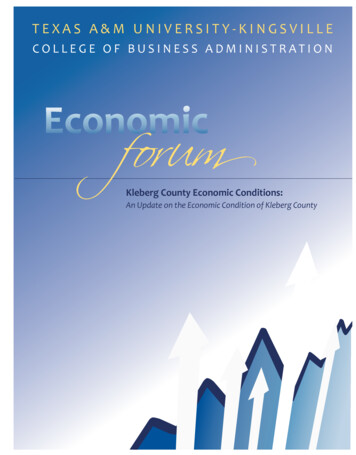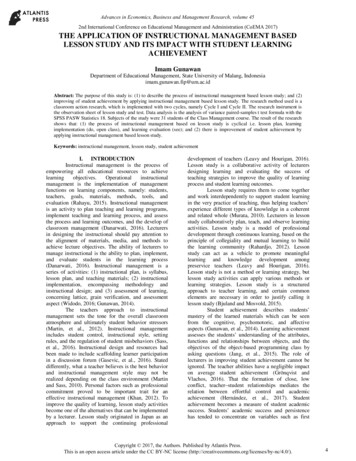
Transcription
Advances in Economics, Business and Management Research, volume 452nd International Conference on Educational Management and Administration (CoEMA 2017)THE APPLICATION OF INSTRUCTIONAL MANAGEMENT BASEDLESSON STUDY AND ITS IMPACT WITH STUDENT LEARNINGACHIEVEMENTImam GunawanDepartment of Educational Management, State University of Malang, Indonesiaimam.gunawan.fip@um.ac.idAbstract: The purpose of this study is: (1) to describe the process of instructional management based lesson study; and (2)improving of student achievement by applying instructional management based lesson study. The research method used is aclassroom action research, which is implemented with two cycles, namely Cycle I and Cycle II. The research instrument isthe observation sheet of lesson study and test. Data analysis is the analysis of variance paired-samples t test formula with theSPSS PASW Statistics 18. Subjects of the study were 31 students of the Class Management course. The result of the researchshows that: (1) the process of instructional management based on lesson study is cyclical i.e. lesson plan, learningimplementation (do, open class), and learning evaluation (see); and (2) there is improvement of student achievement byapplying instructional management based lesson study.Keywords: instructional management, lesson study, student achievementI. INTRODUCTIONInstructional management is the process ofempowering all educational resources to management is the implementation of managementfunctions on learning components, namely: students,teachers, goals, materials, methods, tools, andevaluation (Rahayu, 2015). Instructional managementis an activity to plan teaching and learning programs,implement teaching and learning process, and assessthe process and learning outcomes, and the develop ofclassroom management (Danarwati, 2016). Lecturersin designing the instructional should pay attention tothe alignment of materials, media, and methods toachieve lecture objectives. The ability of lecturers tomanage instructional is the ability to plan, implement,and evaluate students in the learning process(Danarwati, 2016). Instructional management is aseries of activities: (1) instructional plan, is syllabus,lesson plan, and teaching materials; (2) instructionalimplementation, encompassing methodology andinstructional design; and (3) assessment of learning,concerning lattice, grain verification, and assessmentaspect (Widodo, 2016; Gunawan, 2014).The teachers approach to instructionalmanagement sets the tone for the overall classroomatmosphere and ultimately student behavior stressors(Martin, et al., 2012). Instructional managementincludes student control, instructional style, settingrules, and the regulation of student misbehaviors (Sass,et al., 2016). Instructional design and resources hadbeen made to include scaffolding learner participationin a discussion forum (Gasevic, et al., 2016). Stateddifferently, what a teacher believes is the best behaviorand instructional management style may not berealized depending on the class environment (Martinand Sass, 2010). Personal factors such as professionalcommitment proved to be important trait for aneffective instructional management (Khan, 2012). Toimprove the quality of learning, lesson study activitiesbecome one of the alternatives that can be implementedby a lecturer. Lesson study originated in Japan as anapproach to support the continuing professionaldevelopment of teachers (Leavy and Hourigan, 2016).Lesson study is a collaborative activity of lecturersdesigning learning and evaluating the success ofteaching strategies to improve the quality of learningprocess and student learning outcomes.Lesson study requires them to come togetherand work interdependently to support student learningin the very practice of teaching, thus helping teachers’experience different types of knowledge in a coherentand related whole (Murata, 2010). Lecturers in lessonstudy collaboratively plan, teach, and observe learningactivities. Lesson study is a model of professionaldevelopment through continuous learning, based on theprinciple of collegiality and mutual learning to buildthe learning community (Rahardjo, 2012). Lessonstudy can act as a vehicle to promote meaningfullearning and knowledge development amongpreservice teachers (Leavy and Hourigan, 2016).Lesson study is not a method or learning strategy, butlesson study activities can apply various methods orlearning strategies. Lesson study is a structuredapproach to teacher learning, and certain commonelements are necessary in order to justify calling itlesson study (Bjuland and Mosvold, 2015).Student achievement describes students’mastery of the learned materials which can be seenfrom the cognitive, psychomotoric, and affectiveaspects (Gunawan, et al., 2014). Learning achievementassesses the students’ understanding of the attributes,functions and relationships between objects, and theobjectives of the object-based programming class byasking questions (Jang, et al., 2015). The role oflecturers in improving student achievement cannot beignored. The teacher abilities have a negligible impacton average student achievement (Grönqvist andVlachos, 2016). That the formation of close, lowconflict, teacher–student relationships mediates therelation between effortful control and academicachievement (Hernández, et al., 2017). Studentachievement becomes a measure of student academicsuccess. Students’ academic success and persistencehas tended to concentrate on variables such as firstCopyright 2017, the Authors. Published by Atlantis Press.This is an open access article under the CC BY-NC license (http://creativecommons.org/licenses/by-nc/4.0/).4
Advances in Economics, Business and Management Research, volume 45generation status, socioeconomic status, and priorschool achievement (Fong, et al., 2017).The effects on student achievement of thechanges in the teachers’ formative classroom practicethat followed the professional development input(Andersson and Palm, 2017). Teachers can influencestudent achievement, not only directly, but alsoindirectly via peer effects (Feng and Li, 2016;Grönqvist and Vlachos, 2016; Gunawan, et al., 2014).The amount of change in the outcome variable (e.g.,student achievement) is directly proportional to thechange in a context, input, or classroom processvariable (e.g. school size, teacher efficacy, quality ofinstruction, student time-on-task) (Huitt, et al., 2009).The integration of technology into classroominstruction if appropriately implemented has strong andpositive impact on students’ achievement (Olelewe andAgomuo, 2016). Lesson study-based instructionalmanagement can be used as a lecturer effort to improvestudent achievement. Collaboration during lessonplanning in lesson study was a significant predictor ofstudent achievement (Reeves, et al., 2017). Teacherevaluation systems across the country have beenrevised with a renewed concentration on the impact ofteacher quality on student achievement (Rury, 2013;Tygret, 2017). The research questions of this study, is:(1) how the process of instructional management basedlesson study; and (2) whether the application ofinstructional management based lesson study canimprove student’s learning achievement?II. METHODSThis study was conducted using a classroomaction research design. Classroom action research isused because this research seeks to improve teachingperformance of lecturers that is by improving studentachievement in lectures. Lectures are conducted withlesson study. Lesson study is a form of research(Yoshida and Fernandez, 2016). The stages in thelesson study are implementationally similar to theclassroom action research or action research cycle(Kemmis and McTaggart, 2014). Lesson study isconducted by integrating classroom action researchcycle, namely: (1) stage plan, model lecturer withobserver lecturer planning action; (2) stage do, modellecturers carry out lecture activities and observed bythe observer lecturer; And (3) stage see, the modellecturer with the observer lecturer to reflect andevaluate the lectures that have been implemented.The implementation of classroom actionresearch by combining the lesson study in this researchwas carried out with two cycles, namely Cycle I andCycle II. Classroom action research is implemented inthe class of Class Management course, Department ofEducational Administration, State University ofMalang. The subjects are 31 students’ participants incourse. The research instrument used is the observationof lesson study and test. The lesson study observationsheet contains the following statement: (1) whether thestudent is learning about the topic of the course; (2)students who cannot attend lectures; (3) why thestudent cannot learn well; and (4) the effort of lecturersin encouraging students who are not active to learn.The test instrument is used to measure studentachievement. The test is given to the student after thelecture in each cycle. Data analysis is the analysis ofvariance paired-samples t test formula with the SPSSPASW Statistics 18. Paired-samples t test is comparethe differences in the means of the paired samples(Sarstedt and Mooi, 2014). Paired-samples t test wasperformed on two paired samples, paired samplesdefined as a sample with the same subject butexperienced two different treatments or measurements,such as subject A will receive treatment I and then gettreatment II (Santoso, 2000).III. RESULTInstructional Management Based Lesson StudyLesson study based learning process based onbasically refers to process management which includeslearning planning, learning implementation, andlearning evaluation. Learning planning is seen in theactivities: (1) model lecturers and observer lecturersjointly develop lesson plan which refers to annualprogram; (2) identification of materials, media, andlecture methods that will be implemented in the openclass; (3) determine the planned learning model in eachcycle; and (4) determine the time allocation for eachlecture activity. Lecture in every cycle, model lecturerapply cooperative learning model, which is in Cycle Iapply cooperative learning model type Two Stay TwoStray, and in Cycle II combine two learning model thatis Cooperative Integrated Reading and Two Stay TwoStray.Implementation of learning in each cycle is:(1) lecture activities consisting of preliminaryactivities, core activities, and closing activities; and (2)the grouping of students in each cycle to support theapplication of cooperative learning model used. Thegrouping of students aims to assign students tasks, i.e.each group gets the task of discussing the material withgroup discussion first before discussed in classdiscussion. Students in class discussions are given theopportunity to ask questions, answer questions, orrespond to the results of other group discussions.Model lecturers on implementing the activities providereinforcement of the lecture material, givingappreciation and reinforcement to the group that isdiscussing correctly against the course material, andalso explaining the material in more detail if there aregroups that are not appropriate in discussing it.Evaluation of learning appears in theactivities: (1) every cycle of model lecturers andobserver lecturers carry out reflection on lecturesactivities that have been implemented by modellecturers; and (2) appraisal by lecturer model onstudent activity in instructional. Reflection on theimplementation of learning refers to the observationsheet of lesson study. The observation sheet of lessonstudy contains a description of observations byobserver lecturers when conducting observationinstructional. The observer lecturer at the reflectionstage gives advice to the model lecturer in order todevelop the next instructional activity.5
Advances in Economics, Business and Management Research, volume 45IMPLEMENTATION1.PLANModel lecturer and observer lecturer together:1. Develop an RPP that refers to RPS andestablish learning objectives.2. Identify the materials, media, and methods tobe used in the open class.3. Determine the learning model to be used ineach cycle.4. Determine the allocation of time in eachlecture activity.2.Lecture activities consist of preliminaryactivities, core activities, and closing activities.The existence of grouping of students in eachcycle to support the application of learningmodels used.EVALUATION1.2.Each model lecturer cycle and observer lecturercarries out reflection on lecturing activities.Assessment conducted by model lecturers onstudent activity in lectures.Figure 1 The Process of Instructional Management Based Lesson StudyIf it refers to the above explanation, it can beargued that the process of lesson study-basedinstructional management is from activities: (1)learning plan; (2) implementation of learning activities;and (3) evaluation of learning activities. The process ofinstructional management based lesson study refers tocyclical management processes, starting from plan,implementation, and evaluation. The process ofinstructional management based lesson study asillustrated in Figure 1.Improvement of Student Learning AchievementIn accordance with the purpose of research,lecturers apply instructional management based lessonstudy to improve student achievement of participants inthe course of Class Management, with the number ofstudents 31 participants. Here is described the resultsof the implementation of lesson study combined withclassroom action research and scores obtained bystudents in each cycle.Cycle IImplementation of lesson study in Cycle I,first lecturer model make annual program and lessonplan. After the model lecturers make annual programand lesson plan, lesson study activity begins, i.e.implementing open lesson that is the plan phase. Afterthat, carry out lecture activities (phase of do) with openclass. Next perform the see phase with open lesson.Plan PhaseThis stage aims to produce a lecture designthat can learn students effectively and generate studentactiveness in learning. Model lecturers and observerlecturers at the planning stage collaboratively shareideas and ideas in developing lesson plan to produceways of organizing teaching materials, learningprocess, and preparation of teaching aids.The agreement generated at the stage plan are:(1) learning model that will be used is Two Stay TwoStray; (2) learning materials is the basic concept ofclassroom management; (3) using observation sheet ofstudent activeness in giving opinion; (4) using therubric of student writing record; (5) learning tool thatwill be used is laptop and liquid centralium display(LCD); and (6) instructional media used is the materialof impressions about the basic concept of classmanagement materials in the form of Microsoft PowerPoint (ppt). Lecturer observers before carry out phaseof do, prepare material and media to be used.Implementation Phase (Do)This phase is the application of the agreementmade by the faculty team at the phase plan. Suggestionfrom the observer lecturer is taken into consideration ofthe model lecturer to carry out the learning in theclassroom. Model lecturers implement learning inaccordance with lesson plan. Observer lecturers whomake observations during the learning process takeplace. The learning phase briefly consists of threestages. This stage is the syntax of Two Stay Two Straylearning model.Stage 1 lecturers divide the students into 7groups; each group will discuss different subthemeswith other groups by discussion method. Phase 2 sevengroups are divided into small groups, namely groups Aand B, Group A assigns information on the results ofthe group discussion (stay) to the visiting group, whilegroup B is in charge of finding information from othergroups (strays) and the results are recorded. Initiatingthe syntax of the Two Stay Two Stray Learning ModelGroup B visits group A with a rotating system, whichis 7 rounds. The 7th round of group B will return totheir respective groups (early groups). Phase 3 of eachgroup conveys the results of the discussion, and othergroups listen and give inputs or questions to the groupthat presents the results of the discussion, the earlygroup did not present the theme, but presented thetheme of the other group.Reflection Phase (See)Model lecturer together with observer lecturerat stage see together discusses the observation result oflearning activity. The reflection performed togetherwith the observer resulted in the finding that in generalthe learning has run smoothly. Learning activitiesconducted in the classroom in accordance with theplanned, especially on the implementation of Two StayTwo Stray learning model syntax, model lecturersimplement the syntax of Two Stay Two Stray learningmodel correctly. The implementation of learningactivities refers to the learning objectives. The model6
Advances in Economics, Business and Management Research, volume 45lecturer directs the learning consistently, manages thecourse time correctly, conditioned the class to beinteractive, and explains if there is material that thestudents have not understood yet.Act PhaseCycle I reflection results into consideration offollow up activities (act) for improvement of learning.The corrective actions to the RPP which refers to theresults of reflection are: (1) assigning each studenttasks during the learning process with the form ofstudent worksheet; and (2) implementing CooperativeIntegrated Reading learning model which enables eachstudent to have their own activity in the lecture. Theresults of this reflection and follow-up plan areoutlined in the improvement of learning by preparingthe lesson plan that will be applied in Cycle II.Cycle IIThe implementation of the lesson study inCycle II is the result of follow-up from Cycle I. CycleII attempts to improve learning by taking into accountthe problems that arise in Cycle I. The model lecturermakes the RPP by considering the results of reflectionon Cycle I and the suggestions from the observerlecturer.Plan PhaseThe planning phase of Cycle II is modifiedfrom lesson plan based on reflection on Cycle I. Theprevious model lecturer makes lesson plan byconsidering the reflection result from Cycle I. Theagreement resulted in the plan phase is: (1) theimplementation of learning by combining the twolearning models namely Cooperative IntegratedReading and Two Stay Two Stray; (2) learningmaterials are aspects and functions of classroommanagement; (3) using Student Worksheet; (4) usingobservation sheet of student activeness in givingopinion; (5) using the rubric of students’ writingrecord; (6) learning tools that will be used are laptopand LCD; and (7) the instructional media used is thematerial of impressions on the aspect and classmanagement functions in the form of Microsoft PowerPoint (ppt). Furthermore the model lecturer preparesthe learning tool for Cycle II.Implementation Phase (Do)This stage is the application of the agreementmade by the faculty team at the stage of the plan.Model lecturers implement learning in accordance withthe planned RPP. Other lecturers act as observers whomake observations during the learning process takesplace. The learning phase briefly consists of fourstages. This stage is a combination of the steps ofCooperative Integrated Reading and Two Stay TwoStray learning model.Stage 1 lecturers divide the students into 9groups; each group will discuss different themes withother groups. Stage 2 lecturers provide discourse /clipping according to the learning topic to each studentaccording to the theme of the group. Students ingroups, tasked to find the main idea and provideresponses from the results of group analysis ofdiscourse / clipping. Each student recorded the resultsof his group discussion.Phase 3 nine groups are subdivided into smallgroups, namely groups A and B. Group A is taskedwith providing information on the results of groupdiscussion (stay) to the visiting group, while group B isin charge of finding information from other groups(strays) and the results are recorded. Stage 4 of eachgroup conveys the outcome of the discussion, and theother groups listen and provide input or question to thegroup presenting the results of the discussion. Theearly group did not present the theme, but presented thetheme of another group.Reflection Phase (See)Model lecturers together with observerlecturer at stage see together discuss the results ofobservations during the learning process takes place.The reflection performed together with the observerresulted in the finding that in general learning was wellunder way. The observer lecturer responded that themodel lecturer implemented the innovative learningand enabled all students in the lecture. This is becauseevery student is working on a Student Worksheet thathas been designed by a model lecturer. In addition,according to the topic discussed in one of its subtopicsis the innovation of education in the classroom, themodel lecturer not only gives an example by explainingit, but also become an example by applying innovativelearning model and able to activate the students.Model lecturers also direct the learningconsistently, manage the lecture time appropriately,and conditioned the class to be interactive and able toactivate the students. This is different from the do onCycle I that is less in optimizing the individualactivities of students in the group, in this Cycle II isevery student is active in completing tasks individuallyand groups with learning support tools in the form ofStudent Worksheet.Act PhaseBased on the results of reflection on Cycle IIfollow-up (act) to improve the quality of learningcontinuously. The corrective actions to the lesson planthat refers to the results of reflection are: (1) modifythe learning method used; and (2) model lecturers atthe beginning of the lesson provide students with moredetailed explanations on how to work on a StudentWorksheet. Student Worksheet prepared by observerlecturers should be made simpler and there areinstructions for doing.Student Learning Achievement Every CycleStudents in each cycle are given test questionsto measure their understanding of the course material.The results of the tests obtained by the students are alearning achievement in the learning activities. Table 1shows student achievement in each cycle. Based onTable 1 can be seen in Cycle I: maximum score 80,minimum score 47, and average 61.87. And in CycleII: maximum cycle 93, minimum score 73, and average83.55. The mean score of students in Cycle II (83.55)is higher than Cycle I (61.87). The result of varianceanalysis of paired-samples t test formula with the helpof SPSS PASW Statistics 18 found that thesignificancevalueof0.000(Table2).7
Advances in Economics, Business and Management Research, volume 45Table 1Student Learning Achievement Every CycleNoCycle ICycle IINoCycle ICycle IINoCycle ICycle IINoCycle ICycle 15762705265685861,877393828283878383,55XTable 2Paired-Samples T Test Cycle I and Cycle .095.560,000Based on the results of paired-samples t testanalysis using a significance level of 0.05 can be seenthat the value of significance obtained by 0.000 0.05.So Ho rejected and Ha not rejected (Santoso, 2000). Soit can be concluded that there is an increase in studentachievement in the lecture by applying a lesson-basedlearning-based learning.IV. DISCUSSIONInstructional Management Based Lesson StudyThe basic concept of the lesson study is to seehow to improve and develop lessons in real situations(Nesusin, et al., 2014). Lesson study is a collaborativeactivity of educators to develop learning. Lesson studyhas been implemented as a viable approach to supportteachers’ professional development (Saito and Atencio,2013). The teachers eventually implemented theseplans in the classroom and then reflected on the lessonstogether (Saito and Atencio, 2013). The process oflesson study is: (1) defining the problem; (2) planningthe lesson; (3) teaching the lesson; (4) evaluating thelesson and reflecting on its effect; and (5) revising thelesson (Norwich and Ylonen, 2013; Nesusin, et al.,2014; Murata, 2011). The lesson study cycle is carriedout through activities: planning-doing-seeing (Saito, etal., 2006). Lesson study process it includes cyclescomposed of several phases: collaborative planning,lesson observation by colleagues and otherknowledgeable advisors, analytic reflection, andongoing revision (Fernandez, 2010; Lewis, 2002;Stigler and Hiebert, 1999).Lesson study based learning process iscyclical i.e. lesson planning, learning implementation(do, open class), and evaluation of learning (see). Themain stages of the process of lesson study, namely: (1)preparation (preparation / plan); (2) learning lessons;and (3) evaluation (review session) (Baba, 2007).Lesson study is a learning program that involves ateam or learning together from a learning that is done,both on learning by himself and other people’slearning, from the preparation to the implementation oflearning and reflection on the learning. Lesson studybased learning is a collaborative design learningactivity, initiating preparing for teaching, conductinglearning, observing the learning process, evaluatinglearning, and analyzing learning outcomes (Haryoto, etal., 2010; Gunawan, nal management is collaborative educatorsplan learning, implement learning, and reflect onlearning (Ariyanto, 2012). Lesson study learningprocess is collaborative educators: (1) formulatelearning objectives; (2) developing a research lessonplan to realize the objectives; and (3) conducting aresearch lesson with the lesson study participants toobtain evidence of the learning progress of the learners(Lewis, 2002). Lesson study management is a processof managing lesson study starting planning,implementation, and evaluating (Suryanti, 2012).Lesson study management is implemented with theprinciple of collegiality, collaborative, mutual learning,and sustainable. Lesson study lesson management isthe collaborative process of a group of lecturersidentifying learning problems, designing learningscenarios; Educate learners according to scenarios,evaluate and revise learning scenarios, revise revisedlearning scenarios, evaluate learning again, anddisseminate the results to other lecturers (Anggara andChotimah, 2012; Gunawan, 2016a; Gunawan, 2017).Lesson study management aims to transformthe planned curriculum into a curriculum that isimplemented in learning and then there is an evaluationof the learning activities that have been done (Firman,2007; Gunawan, 2016b). Lesson study learning is acollaborative learning that has stages: plan (plan), do(implementation), and see (reflection). Lesson study isa collaborative activity undertaken by a group ofeducators in order to improve the performance andquality of their learning which in turn can improvetheir competence and professionalism (Mahmudi,2009). The purpose of lesson study is to: (1) gain abetter understanding of how students learn andlecturers teach; (2) to obtain certain outcomes thatbenefit other professors in carrying out learning; (3)improving systematic learning; and (4) build apedagogical knowledge, ie lecturers can gainknowledge from other lecturers (Purwati and Supandi,2011).8
Advances in Economics, Business and Management Research, volume 45The benefits of lesson study are: (1) effectiveways to improve the quality of lecturers' learning andstudent learning activities; and (2) acceleratematuration and maturation for young lecturers. Lessonstudy is a staff development program, as theimplementation leaves a significant impact on thequality of teachers and teaching, this concept has beenadopted by other countries and has become a model toimprove the quality of education and teaching(Copriady, 2013). Lesson study a good idea; teacherswith a common focus meet and plan lessons together;these lessons may have a focus on building skills orunderstanding, and are known as research lessons,which are taught by one, and observed by not only allof the teachers who are doing the planning, but also byobservers who, at one end of the spectrum, may comeonly from the teachers’ own school, or, at the other end(Doig and Groves, 2011).The systematic process of lesson studymanagement is the collaborative work of educators todevelop plans and learning tools, observing, reflectingand revising the learning plan in a cyclical, continuousway (Malahayati, 2015). Lesson study needs to bedeveloped to improve the quality of learning byeducators in order to become professional educators(Winarsih and Mulyani, 2012). If it refers to the lessonstudy cycle, then the lesson study activities containunderstanding as a study that attempts to study thepractice of learning in order to develop better teachingimplementation. This is confirmed by Lewis et al.which states that in which they propose three types ofresearch to sustain lesson study practice: (1) expansionof a descriptive knowledge base; (2) explication of theinnovation’s mechanism; and (3) iterative cycles ofimprovement research (Suratno, 2012).The thing to note is that there are differencesin lesson study with classroom action research. Lessonstudy is more emphasized on efforts to improve theability of education in developing learning activities,while classroom action research is a research activitythat aims to solve learning problems and is pragmatic.This is reinforced by Sriyati (2014) which states thatlesson study is a strategy to improve theprofessionalism of educators through learning activitiesfrom other people’s learning, while classroom actionresearch is activity based on research. Actually theprinciple difference between classroom action researchand lesson study is research-based classroom actionresearch, while lesson study is not always researchbased an
THE APPLICATION OF INSTRUCTIONAL MANAGEMENT BASED LESSON STUDY AND ITS IMPACT WITH STUDENT LEARNING ACHIEVEMENT Imam Gunawan Department of Educational Management, State University of Malang, Indonesia imam.gunawan.fip@um.ac.id Abstract: The purpose of this study is: (1) to


